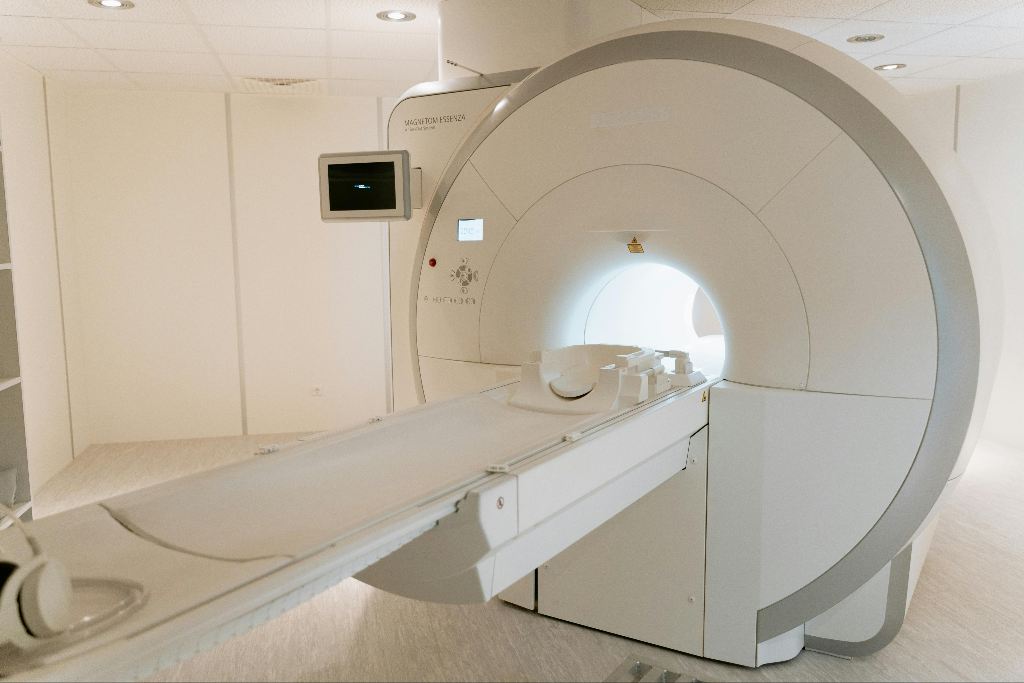A muchas personas, enterarse de que necesitan someterse a una resonancia magnética puede causarles estrés. Las representaciones de las resonancias magnéticas en los medios de comunicación suelen centrarse en el equipo pesado y el espacio reducido que pueden ser necesarios para someterse a una exploración correctamente. Aunque algunos de estos elementos pueden ser ciertos en tu caso, acudir a una resonancia magnética sabiendo qué ocurre y por qué puede reducir el estrés. Al detallar lo que ocurre durante una resonancia magnética de cadera y cuánto puede durar, tu viaje a un centro de diagnóstico por imagen de Atlanta puede ser más fácil.
¿Qué es una resonancia magnética de cadera?
IRM son las siglas de resonancia magnética, lo que significa que es una exploración que utiliza imanes y ondas de radio para representar imágenes del interior de tu cuerpo. Esto se hace sin que sean necesarias incisiones ni cirugía exploratoria. Las resonancias magnéticas se centran en los tejidos blandos del cuerpo, como músculos y órganos, en lugar de sólo en los huesos, como puedes ver en una radiografía.
A menudo, una resonancia magnética se dirige a una zona concreta del cuerpo. Si la zona en cuestión son tus caderas, se realizará una RM pélvica. Las RM pélvicas permiten al médico ver la zona entre las caderas, los órganos reproductores, los vasos sanguíneos y las propias caderas.
Los médicos solicitan resonancias magnéticas de cadera por diversos motivos. Pueden enviarte a esta prueba si tienes un dolor de cadera inexplicable o resultados anormales en las radiografías. Los traumatismos y los defectos congénitos también pueden ser causa de esta prueba de imagen, así como la sospecha de cáncer u otros trastornos en esta región. Si una cadera parece haberse roto o dañado, es probable que te sometas a este procedimiento diagnóstico.
Preparación para una resonancia magnética de cadera
Debido al uso de imanes, deberás tomar algunas precauciones antes de que se realice la resonancia magnética de cadera. Si tienes un marcapasos o algún metal insertado en el cuerpo -incluida la cadera-, el médico puede sugerirte otra forma de prueba, como un TAC. Esto incluirá la necesidad de quitarte cualquier piercing, así como de llevar una bata de hospital para evitar cualquier metal en la ropa.
En algunas resonancias magnéticas se te administrará una inyección de medio de contraste para obtener una imagen más nítida de los vasos sanguíneos. Tu radiólogo lo comentará contigo por si tienes alguna alergia que pueda hacer que esto no sea seguro.
El proceso de una resonancia magnética de cadera
Cuando estés preparado para la resonancia magnética, te llevarán a la sala donde se encuentra la máquina de resonancia magnética. Es una máquina muy grande que parece un donut de plástico con una mesa que se desliza por el centro. La máquina puede resultar intimidante, pero la resonancia magnética es completamente segura para ti. Te tumbarás de espaldas en la camilla; dependiendo de las lesiones que tengas, es posible que te den almohadas o mantas para mayor comodidad.
Una vez estés en la camilla, un técnico te colocará espirales alrededor de la pelvis y las caderas para mejorar la calidad de la imagen. A continuación, te introducirán en el tubo y pasarán a otra sala donde controlarán la máquina y te hablarán por un micrófono. Al comenzar la exploración, la máquina puede hacer ruidos fuertes, lo cual es normal.
La RM pélvica media dura entre 30 y 60 minutos, dependiendo del número de imágenes necesarias para tu diagnóstico. Durante este tiempo, no sentirás que ocurre nada. Es posible que te pidan que aguantes la respiración durante breves periodos.
Algunas personas tienen problemas para estar en un espacio cerrado durante este tiempo, y puedes hablar con tu médico sobre si una resonancia magnética abierta es una opción para tu consulta y tus necesidades.
La resonancia magnética es un procedimiento ambulatorio, por lo que es probable que puedas marcharte inmediatamente después de la exploración. Los resultados de la RM pueden tardar días o semanas, dependiendo de lo exhaustiva que haya sido la exploración. Una vez estén disponibles, tu médico revisará las exploraciones contigo y hablará del tratamiento que pueden necesitar tus caderas en el futuro.
Resonancias magnéticas de cadera en Atlanta
Aunque el proceso pueda parecer intimidatorio, las resonancias magnéticas son una tecnología innovadora e importante que ayuda a diagnosticar una amplia variedad de problemas. En Ortopedia AICA, nuestros radiólogos están altamente formados en la realización y lectura de estas exploraciones para utilizarlas como parte de tu programa de atención integral. Utilizaremos tu resonancia magnética de cadera para el diagnóstico inicial, y luego implicaremos a nuestro equipo multidisciplinar de médicos, fisioterapeutas, quiroprácticos y radiólogos para determinar qué significan los resultados y cómo podemos tratar mejor tus caderas con esa información. Ortopedia AICA también ofrece segundas opiniones sobre resonancias magnéticas existentes, para que puedas utilizar los conocimientos de nuestro equipo para tomar las mejores decisiones sobre tu salud de cara al futuro.





